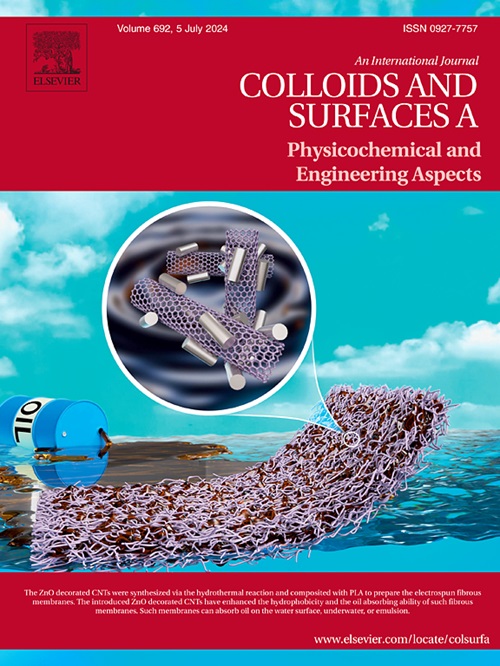Enhanced adsorption of Sr2+ from water by K/N co-doped K2Ti4O9/ZrO2 nanocomposite: Structure, adsorption performance, and mechanisms
IF 5.4
2区 化学
Q2 CHEMISTRY, PHYSICAL
Colloids and Surfaces A: Physicochemical and Engineering Aspects
Pub Date : 2025-07-24
DOI:10.1016/j.colsurfa.2025.137854
引用次数: 0
Abstract
Development of efficient nanocomposite adsorbents is of particular interest for treatment of radioactive wastewater by adsorption. In this study, a novel K/N co-doped K2Ti4O9/ZrO2 nanocomposite (denoted as NTZ-X-Y, X: temperature, Y: time) was synthesized by a solvent thermal coupling solid-phase melting calcination strategy. Detailed analysis indicated that calcination temperature and time, as well as K+/-NH2 doping precisely engineered the mesoporous architecture (BET surface area: 117.46 m2/g; pore size: 7.96 nm) and enriched its active functional groups (Zr-O, Ti-O, O-H, C-N), thereby enhancing its adsorption performance. The optimized NTZ-500–3 exhibited exceptional Sr2+ adsorption capacity (31.76 mg/g). In binary systems with a molar ratio of Sr2+/Na+ or Cs+ of 1:10, the Sr2+ adsorption capacity decreased by only 3.81 and 4.39 mg/g, respectively, only about 1/5 of that of the control group. Thermodynamic analysis confirmed that the adsorption process was spontaneous and endothermic, while kinetic and isotherm modeling, specifically pseudo-second-order (R2 = 0.997) and Freundlich (R2 = 0.995) models, indicated the dominance of chemisorption. Density functional theory calculations further revealed that the adsorption mechanism involved synergistic contributions from ion exchange, surface complexation (predominantly via Zr-O coordination sites), electrostatic attraction, and pore filling. Our findings validated that the dual-functionalization strategy of K+/-NH2 doping combined with controlled calcination created a hierarchical architecture with enhanced accessibility to active sites. This design leveraged the K2Ti4O9 layered structure for rapid ion exchange and the high-affinity surface sites of ZrO2 for selective complexation, offering a promising solution for efficient Sr2+ remediation in radioactive wastewater treatment.
K/N共掺杂K2Ti4O9/ZrO2纳米复合材料对水中Sr2+的增强吸附:结构、吸附性能及机理
开发高效的纳米复合吸附剂对放射性废水的吸附处理具有重要意义。本研究采用溶剂热耦合固相熔融煅烧策略合成了一种新型的K/N共掺杂K2Ti4O9/ZrO2纳米复合材料(记为NTZ-X-Y, X:温度,Y:时间)。详细分析表明,煅烧温度和时间以及K+/-NH2的掺杂精确地设计了介孔结构(BET比表面积:117.46 m2/g;孔径为7.96 nm),并富集了活性官能团(Zr-O、Ti-O、O-H、C-N),从而提高了吸附性能。优化后的NTZ-500-3对Sr2+的吸附量达到31.76 mg/g。在Sr2+/Na+和Cs+摩尔比为1:10的二元体系中,Sr2+的吸附量分别下降了3.81和4.39 mg/g,仅为对照组的1/5左右。热力学分析证实了吸附过程是自发的吸热过程,而动力学和等温模型,特别是拟二阶(R2 = 0.997)和Freundlich (R2 = 0.995)模型,表明化学吸附占主导地位。密度泛函理论计算进一步揭示了吸附机制涉及离子交换、表面络合(主要通过Zr-O配位)、静电吸引和孔隙填充的协同作用。我们的研究结果证实,K+/-NH2掺杂的双功能化策略与控制煅烧相结合,创建了一个具有增强活性位点可达性的分层结构。该设计利用K2Ti4O9层状结构进行快速离子交换,利用ZrO2的高亲和力表面位点进行选择性络合,为放射性废水处理中Sr2+的高效修复提供了一种有前景的解决方案。
本文章由计算机程序翻译,如有差异,请以英文原文为准。
求助全文
约1分钟内获得全文
求助全文
来源期刊
CiteScore
8.70
自引率
9.60%
发文量
2421
审稿时长
56 days
期刊介绍:
Colloids and Surfaces A: Physicochemical and Engineering Aspects is an international journal devoted to the science underlying applications of colloids and interfacial phenomena.
The journal aims at publishing high quality research papers featuring new materials or new insights into the role of colloid and interface science in (for example) food, energy, minerals processing, pharmaceuticals or the environment.

 求助内容:
求助内容: 应助结果提醒方式:
应助结果提醒方式:


